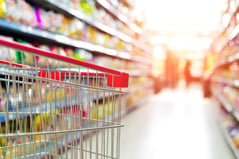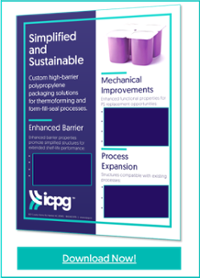 In the food packaging industry, using a material composition that extends shelf life is a key component to ensuring the safety of the product and preserving the taste of the food. In addition, using packaging material that prolongs a products shelf life can drastically cut down on waste of perishable products, and creates a longer window for grocery stores to stock product before it reaches the hands of the consumer. A great way to achieve this is by using a packaging material that reduces the amount of oxygen that permeates the plastic, such as EVOH, incorporating the material into either a multi-layer coextruded rollstock structure, or an extrusion laminated structure. Continue reading to learn more about this barrier material.
In the food packaging industry, using a material composition that extends shelf life is a key component to ensuring the safety of the product and preserving the taste of the food. In addition, using packaging material that prolongs a products shelf life can drastically cut down on waste of perishable products, and creates a longer window for grocery stores to stock product before it reaches the hands of the consumer. A great way to achieve this is by using a packaging material that reduces the amount of oxygen that permeates the plastic, such as EVOH, incorporating the material into either a multi-layer coextruded rollstock structure, or an extrusion laminated structure. Continue reading to learn more about this barrier material.
While traditional thermoplastic resin materials, such as polypropylene, polyethylene and HIPS, all have a certain degree of inherent barrier properties, they are not typically seen as “barrier” materials. Polypropylene, for example, is naturally an excellent moisture barrier but does not perform as well when it comes to oxygen permeability. In order to protect the contents of the packaging from both oxygen and moisture, a barrier material must be incorporated into the composition of the sheet – and this is where materials such as EVOH come in.
So what is EVOH film and how does it contribute to increasing the shelf life of packaged food products?
 EVOH stands for Ethylene-vinyl alcohol copolymer and is a flexible, crystal clear, glossy thermoplastic copolymer. This material has excellent flex-crack resistance, and exhibits a high resistance to hydrocarbons, oils and organic solvents. EVOH is known for having some of the best barrier resistance to gases such as oxygen, nitrogen, and carbon dioxide which makes it particularly suited for packaging food, drugs, cosmetics, and other perishable products. When compared to other common films, EVOH is considered to have superior barrier properties. However, when exposed to moisture, EVOH loses its good gas barrier properties. For this reason, EVOH is often used in a multilayer co-extruded film structure with materials such as HDPE, PP and PET, all of which have superior moisture barrier properties.
EVOH stands for Ethylene-vinyl alcohol copolymer and is a flexible, crystal clear, glossy thermoplastic copolymer. This material has excellent flex-crack resistance, and exhibits a high resistance to hydrocarbons, oils and organic solvents. EVOH is known for having some of the best barrier resistance to gases such as oxygen, nitrogen, and carbon dioxide which makes it particularly suited for packaging food, drugs, cosmetics, and other perishable products. When compared to other common films, EVOH is considered to have superior barrier properties. However, when exposed to moisture, EVOH loses its good gas barrier properties. For this reason, EVOH is often used in a multilayer co-extruded film structure with materials such as HDPE, PP and PET, all of which have superior moisture barrier properties.
Current EVOH Capabilities at Impact Plastics
Currently Impact Plastics’ can incorporate EVOH into rollstock structures through the process of extrusion lamination or multi-layer coextrusion.
Through the process of extrusion lamination, a pre-made EVOH film is wound around a heated chrome roll, fed through the nip of the chrome rolls where the die lip meets, and laminated and bonded to the material being extruded from the die lip. Using this process, the EVOH film is laminated to the outer surface of the extruded sheet whether it is PP, PE, HIPS, etc. The configuration of EVOH on the surface of a monolayer sheet provides sufficient barrier properties, however barrier properties can be dramatically improved by the number of layers the sheet consists of.
Multi-layer coextrusion is a process in which two or more plastic materials are extruded as one. In a standard monolayer sheet extrusion process, one material is fed and extruded through a die. The coextrusion process involves multiple extruders and multiple materials (depending on the structure), and the molten material is channeled through the melt pipes to create a laminar flow for the coextrusion feed block and die technology to weld the extrudates into a one-piece structure. When multiple material layers are combined, the end result yields in a multi-layer structure deriving distinct properties from each material used in the structure. During the extrusion of these plastics materials, the required cooling is achieved by feeding the material through the cooling rolls, also known as the stack rolls or chill rolls. These rolls deliver the required cooling in addition to determining the sheet thickness and the surface texture using specialty surface finish rolls like matte, sand matte, hair cell, etc.
Custom multi-layer coextruded rollstock products produced from ICPG, an Impact Plastics differentiated brand, are compatible with a wide range of processing and sterilization techniques, such as thermoforming and form-fill-seal, for shelf-stable barrier packaging applications, and can be produced with customized barrier properties designed to meet the exact specifications of your application.
Although new and advanced compounded materials are enhancing the properties of traditional plastic materials, coextrusion continues to expand material capabilities for food packaging applications, offering added benefits through the combination of materials in terms of extended shelf-life, cost control and increased structural properties.
For more information on our barrier packaging material solutions, download the data sheet for our revolutionary XPP enhanced barrier polypropylene materials, brought to you by our new brand ICPG:





